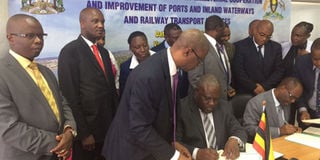Lower cargo transit fees, Uganda asks Tanzania

State minister for Transport Aggrey Bagiire (seated left) and and Tanzania transport minister Makame Mbarawa sign documents in Dar es salaam last week. The two countries want to encourage use of the Central Corridor. COURTESY PHOTO
What you need to know:
- Option. Uganda is looking at Dar es Salaam as an alternative to Mombasa.
Kampala. State minister for Transport Aggrey Bagiire, last week on Thursday asked his Tanzanian counterpart to harmonise the preferential treatment his country offers to transit goods as a way of encouraging the use of the Central Corridor, Uganda’s alternative access to the sea.
Mr Bagiire, while signing a Memorandum of Understanding (MoU) on reviving inland transport on Lake Victoria and development of a railway as part of the Central Corridor, to implore Tanzania to reduce the high road user charges.
Currently, trucks from Uganda are charged $500 (Shs1.7m) each yet Uganda charges only $40 (Shs140,000) per truck from Tanzania.
The exorbitant cargo transit fees, Mr Bagiire said, were discouraging the use of the port of Dar ss Salaam by Ugandan traders since it increases the cost of transportation.
According to a statement issued by the Ministry of Foreign Affairs, which coordinated signing of the MoU, Mr Bagiire asked Tanzania to “consider revising the rates downwards” to attract more traders to use the route.
Dar es Salaam is Tanzania’s principal port with a rated capacity of 4.1 million down weight tonnage (dwt) dry cargo and six million dwt bulk liquid cargo.
Mr Bagiire signed the MoU on behalf of Uganda while Prof Makame Mbarawa, the Transport minister, signed on behalf of Tanzania in Dar-es-Salaam.
The signing was witnessed by the Charge D’Affairs at Uganda High Commission in Dar-es-Salaam, Oscar Edule, Uganda Railways Corporation (URC) managing director Charles Kateba, and other officials from the two countries.
The MoU also reinforces proposed plans by Tanzania to construct, as part of the ongoing construction of the country’s 300km Standard Gauge Railway from the Indian Ocean port of Dar es Salaam, a section to Port Mwanza port at Lake Victoria to link Uganda.
The strategy is now for Uganda to either start revamping Port Bell or start work on Greenfield Bukasa port in Wakiso district earlier-on estimated to cost Shs486b ($180m), to be able to sync with the railway line(s) from Tanzania as part of both the Southern and Central transport corridors, respectively.
Once this railway is realised shipment of cargo is expected to take between 10-11 hours to Port Bell in Kampala.
According to a statement issued by the ministry of Foreign Affairs, Prof Mbarawa described the agreement as a clear testimony that Uganda attaches to Dar-es-Salaam Port as a link in the Central Corridor connecting the two countries.
He said that the current link to Uganda through Lake Victoria is limited since only two ferries are functioning.
Tanzania’s SGR, whose construction was awarded to a consortium of Turkish and Portuguese firms at a cost of $1.215b (Shs4.2 trillion) from Turkey’ state-owned Export Credit Bank, is part of the 1,216kms of the SGR Tanzania is planning to also connect its other landlocked neighbours of Burundi, DR Congo, Zambia and Rwanda.
In his speech, Mr Bagiire underlined government’s aspiration to develop the Central Corridor, which besides revamping Port Bell, will be linked to the Bukasa Port.
Until 1977, in wake of the first collapse of the East African Community (EAC), the East African Railways and Harbours Corporation operated the railway and ports across the three countries, but split into three - URC, Tanzania Railways Corporation (TRC) and Kenya’s Railways Corporation.
The EAC states, along with Zambia also owned the Eastern Africa National Shipping Line Ltd which outlived the EAC up to 1980.
A journey between Kisumu Port in Kenya and Port Bell at most lasted 15 hours and 17 hours between Port Bell and Mwanza with vessel speed of 10 knots.
Today, save for one or two ferries and boats that ply one route to the islands, the neglect is grave a reminder of not only the good old days but the opportunities overlooked as well.
Unusable vessels
In Uganda, Port Bell as the main port and the Jinja pier as a secondary port that were once famed for handling passengers and goods across Kenya’s Kisumu port and Tanzania’s Mwanza and Musoma ports, are now junkyard of sorts.
The collision of two of the three URC operated wagon ferries in 2005-MV Kabalega and MV Kaawa - resulting in the grounding of MV Kaawa, and another MV Pamba by the ministry of Works and Transport for lack of insurance and pending upgrade up to international standards, hence putting the last nail in the coffin of the two ports.
Since then, Port Bell has been choking on heavy siltation, the ubiquitous hyacinth and generally neglect, save for a few private vessels and ordinary boats that recline around.
Different charges
While Rwandan trucks transiting through the central corridor (Dar es Salaam Port) each pay $150 (Shs535,000), other East African member states such as Uganda are charged $500 (Shs1.7 million) per truck for goods in transit. This, traders, have decried several times.




